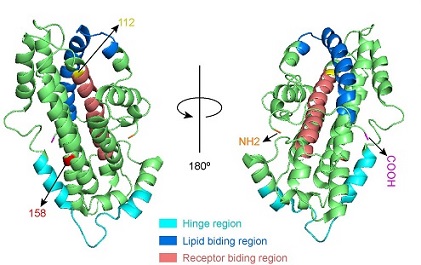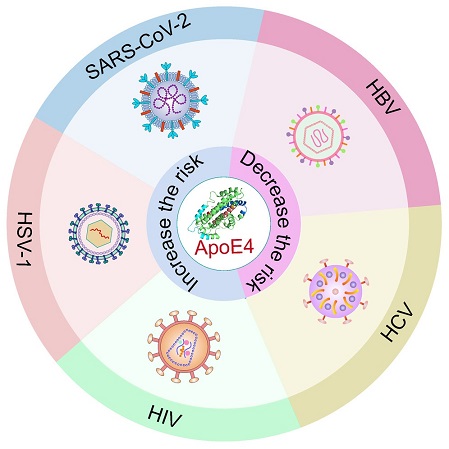Apolipoprotein E and Viral Infections: Unveiling Risks, Mechanisms, and Future Avenues of Research
Thailand Medical News Team Aug 20, 2023 1 year, 8 months, 16 hours, 41 minutes ago
Apolipoprotein E is a multifunctional glycoprotein, renowned for its pivotal roles in lipid transport, metabolism, and cholesterol homeostasis. Beyond its association with neurodegenerative and cardiovascular diseases, ApoE has emerged as a key player in various viral infection-related illnesses. Researchers from the Affiliated Hospital of Guangdong Medical University-China delved into the intricate relationship between
ApoE and viral infections, exploring its diverse effects on diseases caused by hepatitis C virus (HCV), hepatitis B virus (HBV), herpes simplex virus type-1 (HSV-1), human immunodeficiency virus (HIV), and severe acute respiratory syndrome coronavirus 2 (SARS-CoV-2).
 Structural model of human ApoE protein
Structural model of human ApoE protein
Three-dimensional structure of the ApoE protein (PDB: 2l7b). The human ApoE
protein contains three main domains, the NTD (1–167) and the CTD (206–299),
which are joined by a flexible hinge region (167–206). The NTD harbors four
α-helices and contains the receptor-binding region (brown), and the CTD
contains the lipid-binding domain (deep blue).
The Complexity of ApoE: Structure and Functions
ApoE's structural complexity is mirrored in its functional diversity. Comprising two domains - nitrogen-terminal (NTD) and carbon-terminal (CTD), connected by a hinge domain - ApoE's distinct isoforms (ApoE2, ApoE3, and ApoE4) are defined by amino acid polymorphisms. These polymorphisms intricately shape ApoE's conformation, stability, receptor-binding affinity, and lipoprotein interaction preferences. This polymorphism-driven variation underscores ApoE's unique functions and interactions in different contexts.
ApoE in Disease: Alzheimer's and Cardiovascular Diseases
ApoE's role in Alzheimer's disease (AD) is well-established, with the ε4 allele increasing the risk by up to 12-fold. Conversely, ApoE2 is protective, while ApoE3 is neutral. ApoE's impact isn't limited to AD; it also affects other neurological conditions like Parkinson's and cardiovascular diseases. Notably, ApoE−/− mice serve as a prominent model for atherosclerosis research.
ApoE and Viral Infections: A Complex Landscape
The interplay between ApoE and viral infections is multi-dimensional and often contradictory. ApoE4, for instance, heightens susceptibility to infections like HSV-1 and HIV, while protecting against HCV and HBV. The intricate mechanisms underlying these effects are not fully understood, with variations in receptor binding, viral life cycle involvement, and structural differences in ApoE isoforms contributing to this complexity.
ApoE4 and SARS-CoV-2: A Genetic Risk Factor
The global COVID-19 pandemic has brought ApoE's role into sharper focus, particularly in determining SARS-CoV-2 susceptibility and disease severity. Recent research indicates that individuals with the ApoE4 allele face a higher risk of
SARS-CoV-2 infection and worse COVID-19 outcomes. However, the mechanisms driving this susceptibility are still under investigation.
 Graphical Abstract
Potential Mechanisms: Insights and Speculations
Graphical Abstract
Potential Mechanisms: Insights and Speculations
Various potential mechanisms have been proposed to explain how ApoE4 influences SARS-CoV-2 infection and disease severity. These range from altered viral receptor binding and enhanced cytopathogenic effects to the impact on inflammatory responses and ACE2 expression. The unique structural features of ApoE4 and its interactions with spike proteins and ACE2 receptors might contribute to these effects.
Future Directions and Conclusions
The complexities of ApoE's role in viral infections necessitate continued exploration. Key questions revolve around the contrasting impacts of ApoE4 on various viruses and the underlying molecular mechanisms. Investigating how ApoE4 influences viral entry, replication, and inflammatory responses could provide insights into potential therapeutic interventions. Moreover, the potential for ApoE-based therapies to mitigate viral infections warrants investigation, leveraging the knowledge garnered from Alzheimer's research.
Conclusion
The dynamic relationship between ApoE and viral infections is a rapidly evolving field with implications for our understanding of infectious diseases and potential therapeutic avenues. As we navigate the complexities of ApoE isoforms and their interactions with various viruses, we inch closer to unlocking the mysteries of viral pathogenesis and host responses. Further research in this area promises not only a deeper comprehension of viral infections but also innovative strategies to combat these global health challenges.
The study findings were published in the peer reviewed journal: Molecular Therapy Nucleic Acids.
https://www.cell.com/molecular-therapy-family/nucleic-acids/fulltext/S2162-2531(23)00204-4
For the latest about
Apolipoprotein E and Viral Infections, keep on logging to Thailand Medical News.

